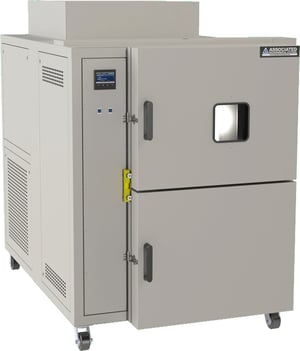Drones, Climate Change and Thermal Shock Chambers
 On August 2nd, UAVOS and Stratodynamics announced that they had accomplished a pioneering flight of the HiDRON glider system. During the test flight, the stratospheric glider drone successfully descended from an altitude of about 98,000 ft. To reach these record-breaking heights, the HiDRON glider hitched a ride on a weather balloon and was then released into harsh stratospheric environment which consisted of temperatures of -60°C and powerful wind currents. Despite these conditions, the HiDRON was able to transmit real-time test data to the ground control system during the flight.
On August 2nd, UAVOS and Stratodynamics announced that they had accomplished a pioneering flight of the HiDRON glider system. During the test flight, the stratospheric glider drone successfully descended from an altitude of about 98,000 ft. To reach these record-breaking heights, the HiDRON glider hitched a ride on a weather balloon and was then released into harsh stratospheric environment which consisted of temperatures of -60°C and powerful wind currents. Despite these conditions, the HiDRON was able to transmit real-time test data to the ground control system during the flight.
The HiDRON can be equipped with several different instrument payloads which will enable scientists to conduct important climate-related research. After the test flight, UAVOS board member and CEO Aliaksei Stratsilatau explained, “HiDRON is a real solution to advancing the important research around climate change and other atmospheric chemistry problems...HiDRON provides solutions to tough problems that affect all of humankind, which is why it is such a capable and necessary platform for researchers.”
Tools like the HiDRON drone will be necessary for scientists to better understand climate change and hopefully help to create solutions for a better future. However, for any of that to happen, those tools will need to be able to withstand the extremely harsh environments scientists deploy them in. Aerospace companies rely on test methods, such as MIL-STD 883K Method 1010.9, to make sure that components used in the industry can withstand extreme temperature fluctuations they will be subject to.
 Associated Environmental Systems SM Series Thermal Shock Chambers are designed to meet the demands of MIL-STD 883K Method 1010.9. Our two-zone thermal shock chambers adhere to the uniform method for thermal shock testing of microelectronic devices within electronic systems. The sample being tested is rapidly transferred between the two zones via a pneumatic elevator. (insert chart below)
Associated Environmental Systems SM Series Thermal Shock Chambers are designed to meet the demands of MIL-STD 883K Method 1010.9. Our two-zone thermal shock chambers adhere to the uniform method for thermal shock testing of microelectronic devices within electronic systems. The sample being tested is rapidly transferred between the two zones via a pneumatic elevator. (insert chart below)
For more information about Associated Environmental Systems thermal shock chambers, visit out SM series page. You can also contact one of our expert representatives by clicking HERE or click the chatbox to the right of this page.


